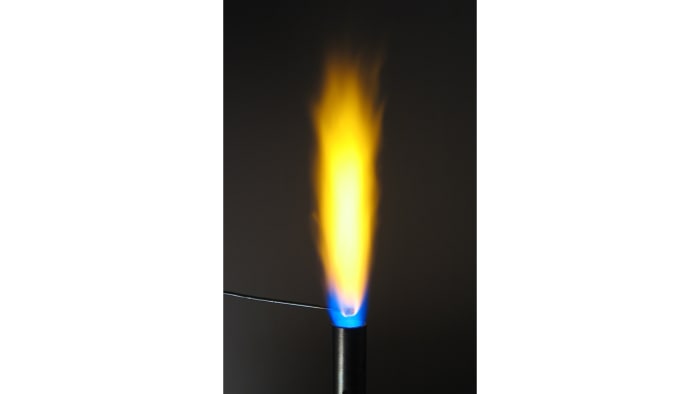Sodium and qualitative reactions to it
How to detect sodium

Sodium is in the 1st group and 3rd period of the Periodic Table. As a simple substance, it is a soft, malleable, silvery-white metal. It displays typical metallic qualities as a simple substance, but sodium oxides and hydroxides have pronounced basic properties. Sodium has high chemical reactivity, and so is stored under mineral oil or kerosene – the metal can react violently with oxygen in the air. There are several qualitative reactions to establish the presence of sodium ions in the composition of its salt.

Obtaining sodium and its chemical properties
Nowadays, metallic sodium is obtained by the electrolysis of a flux of sodium chloride, as a result of which the metal and gaseous chlorine forms:
К⁻: Na⁺ + 1e = Na⁰;
A⁺: 2Cl⁻ – 2e = Cl₂⁰.
2NaCl = 2Na + Cl₂. Sodium has typical properties of active metals.
1. It reacts with oxygen with the formation of peroxide:
2Na + O₂ = Na₂O₂
(Na₂O oxide forms in trace quantities, but it may be obtained by the reaction 2Na + Na₂O₂ = 2Na₂O)
2. It reacts with non-metals with formation of salts:
2Na + S = Na₂S (sodium sulfide)
2Na + Cl₂ = 2NaCl (sodium chloride)

3. It reacts with diluted acids with formation of salts and hydrogen:
2Na + 2HCl = 2NaCl + H₂
(sodium chloride and gaseous hydrogen form)
4. 2Na + ZnCl₂ = Zn + 2NaCl
(sodium is located before zinc in the reactivity series (to the left), and so it can force zinc out of a solution of its salt)
Sodium also reacts violently with water with formation of an alkali:
2Na + H₂O = 2NaOH + H₂
All sodium salts are soluble in water, and so several reactions can be carried out (they are called qualitative reactions) to detect the presence of Na⁺ ions in a salt solution according to various signs (for example, the formation of a sediment or a change of color in the solution).
Qualitative reactions to sodium ions
The presence of sodium in a salt cannot be established visually without conducting experiments. There are several methods for establishing the presence of sodium ions in a solution.
Coloring the flame of a burner

If several salt crystals containing sodium cations are plunged into the flame of a burner, the flame turns green. A reaction can also be carried out with a salt solution. If a metal (for example platinum) wire is soaked in a sodium salt solution and put into the flame of a burner, the color of the flame should change to yellow. It is important that the salt is purified from mixtures as much as possible – cations of other metals (for example potassium or lithium) may “disguise” the color of the flame.
Reaction with uranyl zinc acetate Zn(UO₂)₃(CH₃СOО)₈
Sodium salts reacts as follows with uranyl zinc acetate (or zinc dioxourane(VI) acetate) Zn(UO₂)₃(CH₃СOО)₈ in the presence of acetic acid:
NaCl + Zn(UO₂)₃(CH₃COO)₈ + СН₃СООН + 9Н₂О = NaZn(UO₂)₃(CH₃COO)₉·9Н₂О + HCl
In ionic form:
Na⁺ + Zn(UO₂)₃(CH₃СOО)₈ + CH₃COO⁻ + 9H₂O = NaZn(UO₂)₃(CH₃СOО)₉·9H₂O
The reaction is microcrystalline – to detect the effect, it should be carried out on a microscope slide (if the mixture is heated on the glass at the moment the reaction takes place, the sensitivity of the reaction increases). A yellow crystalline sediment forms which is insoluble in acetic acid. Click here for safe experiments with sodium compounds.
This reaction can be considered specific for sodium ions (it makes it possible to establish the presence or absence of sodium cations in a solution more precisely (compared with a flame), as other cations of alkaline metals do not disguise the result).
The result may be distorted by the presence of ammonia cations NH₄⁺ or potassium cations (K⁺), only if their quantity exceeds the quantity of sodium ions by 20 times. The presence of cations of heavy metals may also interfere – for example, Fe³⁺, Bi³⁺, Hg²⁺ etc.
Impact of potassium antimonate on sodium ions
With the impact of potassium antimonate KH₂SbO₄ on dissolved table salt, the following reaction takes place:
NaCl + КН₂SbО₄ = NaН₂SbО₄ + КCl
The white crystalline sediment NaН₂SbО₄ forms (its formation can be accelerated by cooling the solution or rubbing a glass rod against the wall of the vessel). The reaction is carried out in a neutral or weak alkaline medium, in the absence of cations of other groups and ammonia ions.
A reaction may also be carried out with potassium antimonate(V):
NaCl +K[Sb(OH)₆] = Na[Sb(OH)₆] + KCl
The white crystalline sediment Na[Sb(OH)₆] forms, which is soluble in alkalis. The presence of ammonia ions prevents carrying out a qualitative detection of sodium, as the white amorphic sediment of meta-antimonic acid HSbO₃.
Sodium salts are widely used in industry – for example, physiological solutions are prepared from sodium chloride. NaCl is also used in cooking and municipal services – for example, antifreeze agents are prepared from sodium chloride. Some soluble sodium salts are used as drying agents in organic synthesis.